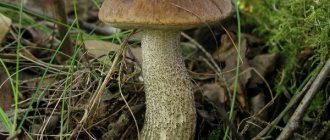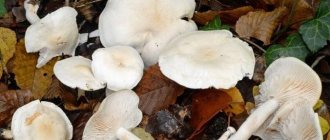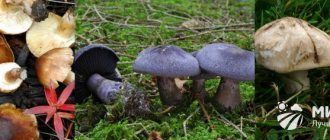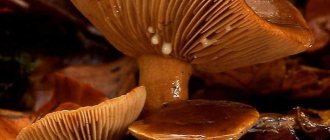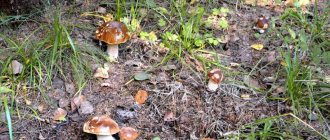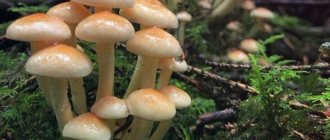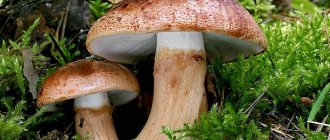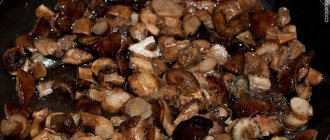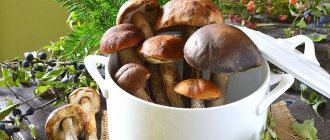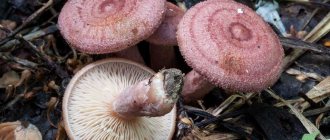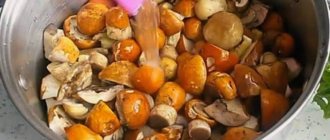The valuable boletus mushroom is one of the most popular in our country. It grows in deciduous forests, most often in birch forests - hence the name. Externally, boletus mushrooms are recognizable, but not everyone knows how to distinguish them due to the fact that there are many varieties of them that differ in appearance. Common names for boletus: birch cap, blackhead, obabok.
Description and features of the mushroom
Boletaceae belong to the genus Leccinum or boletaceae of the Boletaceae family, which includes, in addition to the boletus boletus itself, also the boletus boletus. Forming mycorrhiza with birch, it is usually found near these trees. A characteristic appearance distinguishes boletus mushrooms from other mushrooms:
- The caps are convex, matte, dry. Diameter up to 15 cm.
- The color of the “head” varies from gray to black. There is a variety of mushroom that has a white cap.
- In young specimens the cap is white below, but with age it acquires a gray-brown tint.
- The stem of the boletus is light, slightly thickened (thickness up to 3 cm). It reaches a height of 15-17 cm. It has longitudinal dark scales.
- The flesh of the mushroom is white and does not change color when broken, with rare exceptions. Young specimens are dense and tender inside; when they grow, the flesh becomes loose.
Chemical composition of boletus
The benefits of boletus are due to the large amount of vitamins, fiber, easily digestible proteins and carbohydrates it contains, which it receives due to interaction with the roots of the tree. The nutritional qualities of the mushroom make it similar to meat. It also contains a complete set of amino acids necessary for humans. And in terms of mineral content, it is comparable to porcini mushroom, only slightly inferior to it.
The mushroom contains vitamins of groups C, PP, E, B1 and B2 and minerals such as:
- potassium - most of all;
- manganese – 37% of the daily value;
- calcium – 18% of the daily value;
- phosphorus;
- sodium;
- magnesium;
- iron.
The dense, fleshy part of the boletus mushroom is a source of coarse dietary fiber. Its value lies in its well-balanced protein.
The nutritional value of boletus is as follows:
- per 100 g of product – about 20 kcal;
- water – 90.1 g;
- fiber – 5.1 g;
- proteins – 2.3 g;
- carbohydrates – 1.2 g;
- fats – 0.9 g.
Taste and use in cooking
In terms of taste, aspen mushrooms are second only to the king of the forest - the porcini mushroom. Their flesh is denser than that of boletus and less juicy. They have a wonderful rich mushroom taste and aroma. The stem of mature fruiting bodies becomes too hard, so it is less often used for cooking. First courses of boletus are not often prepared, as the broth turns blue-black. Basically, they are fried, pickled, salted and dried, and for pickling it is better to use younger specimens, and it is optimal to dry or fry mature ones.
The boletus pulp spoils quickly, so it is better to collect young fruiting bodies. They are also rarely used for making soups due to darkening during heat treatment. It is recommended to cook boletus mushrooms together with other types of mushrooms, since their taste is not very pronounced. This type can be fried, pickled, dried, salted. Boletus mushrooms make an excellent filling for baked goods, pancakes, dumplings, etc.
Important! To reduce the darkening of the flesh during cooking, soak the mushrooms for 20–30 minutes in a vinegar solution (1 part vinegar and 5 parts water).
The value of boletus
In terms of value, boletus ranks second after boletus, the “king of mushrooms.” It is eaten in any form: boiled, fried, dried, pickled. Obabki are well preserved for the winter in dried or salted form. Subsequently, sauces, fillings for pies and just snacks are obtained from the preparations. It is advisable to choose young mushrooms from the forest, especially for pickling.
Boletus is a rare example of a mushroom that is useful to everyone without exception. In rare cases, one can talk about intolerance to mushroom cultures, only then it is not recommended to eat mushrooms. It brings only benefits to the rest. The dietary fiber of the pulp, entering the stomach, acts as an absorbent. They collect all harmful particles from digested food and remove them naturally. Due to the content of large amounts of potassium and phosphorus, the mushroom is useful in that it improves the functioning of the kidneys and adrenal glands, and also regulates blood sugar levels.
The benefits of obobka are as follows:
- Clears away toxins.
- Good for the skin.
- Normalizes the functioning of internal organs (liver and kidneys).
- Improves the structure of enzymes.
- Enriches with useful elements.
You can eat it while on a diet. Boletus, like any mushroom, is a good meat substitute. But it is advisable to make soups from it, less often - fry it and not eat it in salted form. An ideal option for dietary nutrition is mushroom pie, stew or boletus sauce, used as an addition to other dishes.
Benefits and possible harm
Boletus and boletus, like other mushrooms, consist of 90% water. It also contains proteins, fiber, carbohydrates, minerals and fats.
- By including mushrooms in your diet, a person receives the following benefits:
- cleansing the body of toxins;
- improving the functioning of the central nervous system;
- reduction of kidney problems;
- normalization of blood sugar.
Mushrooms are also useful for the skin and mucous membranes of the body, and help in the treatment of problems of the musculoskeletal system. In terms of amino acid content, mushrooms are equal to meat, only they are less caloric and less digestible.
To get the maximum benefit from eating mushrooms, you need to follow the cooking technology: chop well, boil and fry the fruiting bodies. Allergy sufferers, elderly people, and patients with gastrointestinal and liver diseases should not eat them.
Important! A child’s body develops gradually, so you should not give mushrooms to children under three years of age.
There will be no benefit from this, and the child does not need any extra stress on the digestive organs. When going into the forest, arm yourself with a sharp knife to carefully cut off the fruiting bodies and not spoil the mycelium. After harvesting, process the mushrooms as quickly as possible. Choose your favorite recipe and delight yourself and your family with aromatic, tasty and healthy mushroom delicacies.
Types of mushrooms and their growth
Boletus mushrooms are common mushrooms that come in several varieties. There are four main ones: ordinary, black, white or swamp, pinkish. Other varieties are less popular. They are combined into a common group or called close relatives with the common boletus and its relatives (presented above). This is due to the fact that they differ in appearance, distribution area and even taste.
Common boletus
The most valuable (from a culinary point of view) representative of the species and the best in taste. It has all the advantages of an edible mushroom. The appearance is classic for boletus: the leg is strong, may have a thickening at the bottom, the cap is smooth, brown, and shaped like a hemisphere. It is uniformly colored, ranging from light gray to dark brown. The color depends on the growing conditions, as well as the type of tree with which the mycorrhiza is formed. It doesn't have to be birch.
The mushroom grows on the edges, clearings, birch forests, and among young trees. As a rule, it chooses mixed forests; in some years the yield is high - the mushroom is found in large quantities. Often boletus can be found in spruce plantings interspersed with birch trees. Mushroom pickers “hunt” the common boletus from the beginning of the summer season until late autumn.
Black birch
Its other name is blackhead. The mushroom is distinguished by a darker, brown cap, smaller in diameter than the ordinary one. With age, the cap becomes even darker. Its surface is dry, but after rain it becomes slimy. The length of the leg is about 12 cm, dark scales appear on it. The pulp is firm and acquires a bluish tint when cut. The tubes are large, dirty white or gray in color.
Blackheads are a rarer type of mushroom compared to their relatives. They prefer to grow in damp places: along the edges of swamps, in pine forests, thick grass, and do not shy away from birch forests. They grow from August to November - this is a late variety of mushrooms. In terms of taste, the dun cap is not inferior to the common boletus. Finding it in the forest is the joy of a mushroom picker.
White (marsh) boletus
The distribution area of this fungus is swampy areas, mossy darkened forests, and flooded birch forests. Hence the name - swamp. Outwardly it differs from its relatives with a light, almost white cap. In young specimens it has the shape of a hemisphere; with age it becomes more prostrate, but does not open completely. White scales appear on it, which darken as they dry.
The skin and pulp may have a greenish tint, and the spore powder is ocher in color. The leg turns blue downwards. The pulp is loose and breaks easily. It does not have a strong odor or color. In terms of taste, the boletus is inferior to the common boletus - it is more watery and inconspicuous. The mushroom is found quite often, but is not very productive. Mushroom pickers find marsh boletus from mid-summer to October.
Pink boletus
The pink or oxidizing representative of the ape differs from its relatives by a low, thin leg, which tends to bend in the sunny direction. The cap is cushion-shaped, the skin is gray-brown to brown in color. The tubular layer is whitish, becoming dirty gray with age. When cut, the flesh does not darken, like everyone else’s, but turns slightly pink, acquiring a brick-pink hue. Hence the name.
The pinkish species is found in northern forests mainly in autumn. Grows in swampy areas, in birch forests in damp areas. As a rule, mushrooms are found in groups and grow separately. They form mycorrhiza with birch. Pink beetles are rare; they prefer peat bogs overgrown with moss or dense grass thickets. Mushroom pickers can find them along the way of collecting cranberries: around lakes, drying swamps, in damp forest depressions.
Gray boletus
Its other name is elm or hornbeam. The fungus, common in the Caucasus, forms mycorrhiza with hornbeams, trees from the birch family. But it can also be found under other deciduous trees - hazel, poplar, birch. Fruits from June to October. Externally, it is not very different from the common boletus.
The hornbeam's cap is olive-brown or brown-gray, with folded edges. Its surface is velvety and uneven. The skin of mature mushrooms sometimes shrinks, exposing the cap's flesh and porous layer. The pores of the fungus are very small, angular-round in shape. On the stem the flesh is fibrous and white, but when cut it becomes pinkish-violet, then gray, to almost black.
Ash gray dog
This type of boletus got its name from the color of the tubular layer at the bottom of the cap. If you cut the flesh, it will turn pink and turn blue or green at the base. The skin of the cap is light brown, becoming darker as the mushroom grows. The surface is smooth, the shape is convex. The leg is long and thin, whitish in color, but with loose dark scales. The ash-gray boletus is edible, but its taste is mediocre. Fruits in autumn.
Checkerboard or blackening boletus
This representative of the genus obabkov is found in beech forests or oak groves, forming mycorrhizae with these trees. Distributed in the Caucasus. The mushroom cap is yellow-brown, the tubular layer and spore powder are lemon yellow. In youth, the cap has the shape of a hemisphere, then it becomes cushion-shaped with a blunt edge. Its diameter is up to 15 cm. When cut, the pulp becomes dark (purple) and then turns black. The leg is cylindrical or club-shaped and thickened at the bottom.
Stiff boletus
The obabok is harsh, hard, poplar-like. It got its name because of the hard flesh of the mushroom. This has a positive effect on its taste. At the break, the flesh turns red and blue (in the upper and lower parts of the leg, respectively). The diameter of the cap is 6-15 cm. At first it is hemispherical, and later convex, sometimes with a depressed center in mature mushrooms. The skin is slightly pubescent when young, but becomes matte and smooth. The color of the cap is extremely variable. Young mushrooms have the same color as the flesh, the shade varies from gray-brown to ocher or reddish-brown.
Stiff-haired obabok grows in mixed forests, forming a symbiosis with aspen and poplars. Occurs singly or in rare groups. Selects calcareous and sandy soils, loam. This is a rare species of boletus, you need to go looking for it in the summer (from July) and autumn (it bears fruit until mid-November). Recently, the harsh little dog has been seen more and more often and in larger quantities.
Multi-colored obabok
The cap of this type of boletus is variegated, mouse-colored, as if shaded. The white flesh turns pink when cut, and turquoise on the stem. The pores of the tubular layer are creamy. The length of the stem depends on the height of the moss above which the mushroom needs to rise. It is light and thick. A blue tint may appear at the bottom of the leg. The scales are gray. The multi-colored species is similar to the common boletus, it also bears fruit and is found in the southern latitudes of our country. But this type of obabka is not in demand among mushroom pickers, as it is difficult to prepare and does not taste very good.
When to go on a quiet hunt
progorodnn.ru
To catch noble species in the forest, you should go mushroom hunting in the early hours, starting at dawn, between mid-July and the end of August.
Why so early?
Firstly, you are not the only mushroom lover, others also want to grab their share of the harvest, and if you manage to get ahead of your mushroom pickers and competitors, then the youngest, freshest and juiciest ones will go to you! And you won’t have to go far into the forest; you’ll quickly fill your basket full.
Secondly, summer is a hot time and in order not to sweat, it is better to visit the forest in a cool and fresh time. But remember that it is better to wear rubber boots or boots that will not get wet during the hunt, because... There will be a lot of dew, and dry feet are comfort.
Thirdly, hiking in the morning is safer, going in the middle of the day or worse - in the evening it’s not right, whatever one may say, the forest is a high-danger zone and you can get lost there, the best option is to take a partner with you. Read more about precautions in the forest below.
Where and when to collect boletus mushrooms?
The distribution area of boletus mushrooms is quite wide. They are found throughout the country. Mushrooms prefer to grow in deciduous and deciduous-coniferous forests, birch forests, and can be found in parks and on the edges of young growth. Favorite places are the edges of clearings of mossy forests, the edges of ravines. Obabkas prefer calcareous soils, but are also found in other places.
Boletus mushrooms love warmth and, as a rule, grow where the soil is well warmed by the Sun.
The collection time for obabkov is the entire summer season, starting from the end of May and ending in October. The common boletus is found until the first frost. Mushrooms ripen at the same time as porcini mushrooms, perhaps a little earlier. Some species (depending on where they are distributed) appear first and last longer.
Boletus mushrooms are famous for their rapid growth. Over the course of a day, the mushroom can add up to 4 cm and up to 10 g of weight. But after 5-6 days it begins to age. Therefore, it is recommended to collect young specimens; they are tasty, crunchy and, as a rule, not wormy. Adult mushrooms are looser.
Places of distribution
Boletus grows in light mixed and deciduous forests, less often in spruce forests, forming mycorrhiza with birch roots (hence the name). You need to look for them in open clearings with good access to sunlight and at the edges of the forest. They grow in Eurasia, forests of South and North America, as well as in tundra conditions under dwarf birch trees.
The boletus prefers moist, shady places in mixed and deciduous forests. Mycorrhiza can form with many trees: aspen, birch, oak, poplar, spruce, etc. You need to look for them in lowlands, thickets of grass, blueberries, ferns, in moss or near a forest road.
Similar mushrooms
All plants have a characteristic appearance, regardless of color and place of growth. But when picking mushrooms, you should be careful, especially if a pinkish or blackening species comes into view. There is a risk of confusing such a boletus mushroom with its inedible “double,” the main one being the gall fungus. There are other doubles that can be put in the basket instead of the obabka due to inexperience.
Bile mushroom
A conditionally edible mushroom known as bitterling. It is called a false twin of such representatives of boletaceae as boletus, white boletus and boletus. The mushroom resembles a boletus in the shape of a cap (hemispherical), the color of which can be light or dark brown, gray, grayish-brown, dark brown, yellow-brown. The leg is dense, fleshy, swollen downwards. But instead of longitudinal scales, reminiscent of the color of birch trees, the gall fungus has veins, like vessels.
Other features of bittersweet that should alert the mushroom picker:
- The tubular layer of the mushroom turns red when cut, and the tubes initially have a yellowish tint. Externally, the fruit body is attractive. Insects, slugs and worms will not attack the mushroom.
- The surface of the cap is usually velvety, whereas that of the caps is smooth. In high humidity, the roughness smoothes out when touched. If this does not happen, you have an inedible double.
The gall mushroom is not poisonous, but when cooked it gives a strong bitterness, which only intensifies. It is impossible to eliminate it by cooking and frying; the unpleasant taste is neutralized only by a large amount of spices and long soaking in vinegar. In terms of nutritional qualities, bitterling is many times inferior to boletus. Although a single consumption of this mushroom does not cause serious poisoning, it is advisable to avoid it. The main rule when meeting such a “boletus” is “If in doubt, don’t take it!”
Death cap
An extremely poisonous representative of the genus Fly Agaric does not belong to the tubular mushrooms, like boletus, but sometimes grows in the same place: in coniferous, deciduous, broad-leaved forests under birches, beeches, aspens, oaks - and at the same time, from July to October (until the first frost ). It is quite rare. There is a risk of confusing a toadstool, especially a young one, with a toadstool in appearance:
- Her hat is flat-convex and beautifully shaped. May have a white or brown-olive color, turning gray with age. In the middle it is darker, with shine. In humidity it becomes slimy.
- The toadstool leg has a characteristic pouch - a ring, but in young mushrooms it is not very pronounced. The length of the leg reaches 12 cm.
- The pulp is thin, light, and has no pungent odor. And it doesn't change color either.
The main difference with boletus is the plates under the cap. At any age, they remain white and clearly defined; Boletaceae have no plates under the cap. In addition, the boletus does not have a so-called volva at the base - a film half buried in the ground. It is worth paying attention to these features so as not to confuse the edible toadstool with a poisonous toadstool. The danger of the latter is that even its spores and mycelium pose a threat. For fatal poisoning, 1 g of raw mushroom per 1 kg of weight is enough.
Pepper mushroom
A close relative of the moss fly, the butterfly, belongs to the boletaceae family. It grows next to boletus, forming mycorrhiza with birch. The fruiting period is from July to November. The pepper plant has a brown, rounded-convex cap, reminiscent of a boletus cap. Its shape is round-convex, diameter is up to 6 cm, the surface is dry and velvety. You can confuse the pepper mushroom with a young mushroom. The leg of the double is thin and yellow in color. It turns red when cut. The smell is not strong, but the taste is sharp - if you lick a pepper mushroom, it will immediately become clear that this is not a boletus mushroom.
Pepper mushroom is not poisonous, but is inedible due to its pungent, bitter taste, reminiscent of pepper. It can be used as a spicy seasoning, but if by mistake such a fungus gets into a soup or roast, the dish will be hopelessly spoiled. To prevent this from happening, you need to carefully examine the fruiting body. How to distinguish pepper mushroom from boletus mushroom?
- The boletus has a light leg with dark scales, while its counterpart has the same color - rusty, yellow, and matches the color of the cap.
- The mushrooms do not have a brightly colored spongy substance, like pepper mushrooms. Their layer under the cap consists of small red-colored tubes filled with powder. If you press on them, a red liquid will come out.
Education dispute
Spores (special cells with the help of which mushrooms reproduce) are formed in tubes or on the plates of the cap. The spores are very small and light. After ripening, they spill out, are easily picked up and carried by the wind.
In addition, they can be spread by insects and slugs, as well as squirrels and hares that eat mushrooms. In the digestive organs of these animals, the spores are not digested and are thrown out along with the droppings.
Once in moist, humus-rich soil, fungal spores germinate and mycelium threads develop from them.
Only occasionally can a mycelium grown from one spore form new fruiting bodies. In most species of fungi, fruiting bodies develop on myceliums formed by fused cells of filaments grown from different spores. A feature of this fusion of two cells is the process of interaction of their nuclei. They do not merge, but only connect in pairs. Therefore, the cells of such a mycelium remain binuclear for a long time and only then merge.
The mycelium grows slowly, and only after accumulating sufficient reserves of nutrients does it form fruiting bodies.
The difference between boletus and boletus
Another mushroom-twin of boletus is boletus, of the same genus, even group. It is an edible member of the boletaceae family that grows under aspen trees. Outwardly, it is very similar to the boletus and is just as valuable. If you happen to confuse the two types of these mushroom crops, the collector will not lose. Boletuses rarely worm, unlike the loose, watery boletus, which prefers moist forests. The structure of the boletus pulp is less porous and hard. The leg breaks easily. When cooked, aspen produces a pleasant, bright smell, ideal for frying.
A distinctive feature of the boletus - a bright red cap - is not typical for all species:
- For example, gray-brown aspen forms mycorrhiza with birch; Because of the cap, it can easily be confused with an ordinary cape, especially if it has a yellow-brown tint.
- White boletus is all cream in color and grows in pine forests. It can easily be confused with a swamp lump.
- Depending on the place of growth, both boletus and boletus may have the same cap color - chestnut-brown.
As a rule, boletus mushrooms are stronger than boletus mushrooms. This applies to both the massive stem and the cap, which in young mushrooms is not spread out, but spherical, pressed against the stem. The lower part of the cap of the boletus is loose and soft, and during heat treatment it becomes very soft, which cannot be said about the boletus. The main difference between these two mushrooms is that the flesh of the boletus turns purple or blue when cut. But the boletus does not change color, it only turns slightly pink.
Comparative characteristics
Young boletuses and boletuses are often confused even by experienced mushroom pickers. Not only do they belong to the same genus Leccinum, but they also look approximately the same. Differences appear during the growth process. Confusion is not dangerous, because both mushrooms are classified as edible.
The table will help you remember the differences between them:
| Boletus | boletus | |
| hat | Dull, gray or brown | Bright, red or orange |
| Leg | Long, wide, tapered at the top | Equally strong and massive |
| Pulp | Thick consistency, the cap gets wet in water | More dense, does not get wet |
| Slice | The pulp is white or pinkish | The flesh is white, turns blue when cut |
These mushrooms have the same ripening period: it begins with the arrival of summer and lasts until the end of autumn. Boletuses bear fruit in three stages. The first occurs in June - July, then several weeks in mid-summer, and the longest last stage, which begins at the end of August and lasts until the onset of cold weather.
A characteristic feature of boletus is irregular fruiting. There are seasons when the yield is very high, followed by a dormant period.
You will be interested to read how quickly boletuses grow after rain.
Self-cultivation of boletus mushrooms
The famous boletus mushroom can be grown independently, on a garden plot or in a specially designated area, not only for personal use, but also for sale. The business is profitable and does not require much hassle. In addition, compared to other mushrooms, boletus mushrooms are famous for their high yield. You just need to properly care for the garden bed. It is better to plant mushrooms in May-June.
The most difficult thing is to obtain the mycelium of the fungus. Boletus mushrooms are distinguished by the fact that their spores are difficult to separate from the pulp. Knowing this, manufacturers of ready-made mycelium sell boletus substrate ready for planting. This saves the future farmer's time. The cost of a 60 ml package is small - up to 200 rubles. If it was not possible to obtain ready-made mycelium for planting, you need to prepare a mixture that will precipitate the mature spores.
How to germinate mushrooms naturally? First of all, you need to get the spores. They are contained in the mushroom pulp, which must be separated from the cap, minced through a meat grinder and placed in a container with water. Further scheme of action:
- Dry yeast is added to the mixture - a nutrient medium for the propagation of spores.
- The liquid is infused for a week. Then the foam is removed from the surface, the water (the middle part) is drained, and the sediment - these are the spores - is diluted in a new portion of water. Ratio – 1:100.
- This liquid is poured into the birch roots, which must first be opened.
- The area is moistened again.
This is the main condition for germinating mushrooms - maintaining the recommended humidity level. The soil should be sprayed regularly from a spray bottle, simulating mushroom rain. It is advisable to water in the afternoon so that the sun's rays do not dry out the soil. It is good when there are several low plants next to the planting that will protect the clearing from direct exposure to ultraviolet radiation.
The technology for growing boletus mushrooms is to create conditions that are as similar as possible to their natural growth environment.
If ready-made mycelium is available, it can be planted in pre-prepared holes in accordance with the instructions on the package. Don't be overzealous; 3-4 holes for seeds are enough. Their depth is on average 20 cm, diameter - 10. They are placed around the circumference of a tree (birch), preferably not a young one, over 5 years old. It is good when there are several trees, perhaps they are mixed with other species.
How to germinate mushrooms in holes:
- Birch sawdust (or soil with a high peat content) is placed in the prepared holes, followed by forest humus. Then a small piece of compost mycelium is placed. 1/3 of the bag per 1 hole, if the product is ready.
- Each depression is filled and compacted.
- The holes are watered abundantly - at least a liter of water. You can add fertilizer or use preparations containing microorganisms for watering.
- It is also necessary to moisten the soil around the plantings.
- To maintain moisture, the planting is covered with a layer of straw, which is constantly watered, with moss or leaves. The plantation should be moistened at least once a week, at least 3 buckets of water are poured under each hole during this period.
- With the onset of cold weather, straw is replaced with leaves or moss. It is recommended to cover the area within a radius of 2 meters (at least during the first winter) with insulating material: both the holes themselves and tree roots. The covering layer is removed with the first warming.
The planted seeds will produce their first harvest only after a year. After this, active fruiting will be observed for 5-7 years. At this time, you can expand the plantation and make new holes. The volume of the harvest depends on how the growing conditions were maintained. It is also important to choose the right variety of mushrooms that will grow on the site. Their natural distribution area and weather conditions should be similar to artificially created ones.
The advantage of growing boletus mushrooms yourself is the opportunity to harvest young mushrooms. They are tastier, stronger than adult specimens, which become loose over time, and are suitable for any dish - pickling, soup, roast. Timely collection will not allow boletus mushrooms to deteriorate in the garden, lose their valuable taste and be attacked by worms, slugs and other harmful insects.
The boletus is a tasty mushroom that mushroom pickers enjoy hunting for. It is good in any dish, has no contraindications for consumption, and is famous for its excellent taste. Big fans of this mushroom can grow it themselves if they wish. If a birch tree grows on or near your summer cottage, you can plant several beds with pre-prepared mycelium around it, and wait for the results for the next season.
0
0
Copy link
